Kos › Asia Minor » Ancient origins
Articles and Definitions › Contents
- Kos › Ancient History
- Asia Minor › Antique Origins
Ancient civilizations › Historical and archaeological sites
Kos › Ancient History
Definition and Origins

Kos ( Cos ) is a Greek island in the south-east Aegean (ancient) Sporades group which prospered in antiquity due to its location on trade routes between Egypt, Syria, Cyprus, and Anatolia. Settled from the Bronze Age, the island was controlled by a long list of powers over the centuries. One of Kos' most famous sons was the celebrated physician Hippocrates, who created a school of medicine on the island in the 5th century BCE. Kos particularly flourished both politically and culturally in the 4th century BCE, after which it became a free city as part of the Roman Empire.
BRONZE AGE KOS
In Greek mythology, Eurypylos is mentioned as the king of Kos and contributor to the Greek army involved in the Trojan Warof Homer ’s Iliad. In the same book we are told that Hera removed Hercules to the island when he was trying to return home after his sacking of Troy. The first archaeological evidence of settlements on Kos confirms an even earlier Bronze Age presence (3rd millennium BCE) with burial jars and metal objects such as daggers being excavated. Middle Bronze Age finds also demonstrate an influence from Minoan Crete and contact with Egypt.
The first large settlements, such as Serayia (Seraglio), have fortification walls and tholos tombs dating to the Mycenaean period (1600-1200 BCE). The island was, no doubt, selected as a useful stopping point on the ancient Mediterranean trade routes between the Levant, Egypt, and Anatolia. Kos was also one of the most fertile Aegean islands. Kos-made pottery was traded with other islands and has been discovered at Trianda and Akrotiri on Thera. Following the collapse of the Mycenaean civilization in the late Bronze Age, the island was next occupied by Doric settlers from mainland Greece, probably Epidaurus. The Serayia cemetery, in use from c. 1050 BCE, dates to this period. It was last used c. 750 BCE, indicating a new cultural influence had arrived.
THE GREAT PHYSICIAN HIPPOCRATES WAS BORN ON KOS WHERE HE FOUNDED A SCHOOL OF MEDICINE WHICH BECAME FAMED THROUGHOUT THE GREEK WORLD.
ARCHAIC & CLASSICAL KOS
From the Archaic period the island came under control of various powers – first Persia, then Halicarnassos, and finally Athens. The most important cities on the island were Astypalaea, Cos Meropis, and Halasarna. In the 5th century BCE, the great physician Hippocrates was born on the island where he founded a school of medicine which became famed throughout the Greek world. From this period, Kos also became a noted exporter of wine and minted its own coinage, perhaps the most famous example of which are the silver tridrachmas which depict a discus thrower ( discobolus ). In the battle of Salamisbetween Greek and Persian forces, Kos supplied several ships to the Persian cause, in an island fleet commanded by Artemisia I of Caria. According to Herodotus, the tyrant Kadmos gave the people of the island control of government c. 480 BCE.

Tridrachm, Kos
Kos subsequently came under the control of Athens and became a tribute-paying member of the Delian League. This offered no particular protection to the island as Kos was sacked by the Spartan general Astyochus in 412 BCE after he took advantage of the disorder caused by a recent and devastating earthquake. According to Thucydides, the Athenian general Themistocles responded by building fortifications on the island in 411 BCE. In 366 BCE all the cities of Kos joined together to form a single political entity. A new city was, consequently, founded on the north-east coast, then fortified, and a harbor created. Mausolus, ruler of Caria, invaded the island in the 350s BCE. In 332 BCE Amphoterus, admiral of Alexander the Great, took possession of the island.
HELLENISTIC & ROMAN KOS
Following the Successor Wars after Alexander ’s death, Kos regained its independence, established a democratic government and constitution, and became an ally of the Ptolemy dynasty based at Alexandria. Kos exported wine, olive oil, and silk to cities across the Aegean and the Black Sea. Its long-lasting trade and cultural ties with Egypt are illustrated by the fact that Ptolemy II was born on the island and Cleopatra II sent her treasury to Kos c. 102 BCE. A period of cultural activity expressed itself in such figures as the influential Kos poet and scholar Philitas (born c. 340 BCE) and his contemporary the poet Herodas.In 242 BCE the island's games held in honour of Asclepius were given Panhellenic status, like those at other sacred sites such as Delphi and Olympia. Records describe athletes coming from over 50 different cities to participate, and those were just the winner lists.
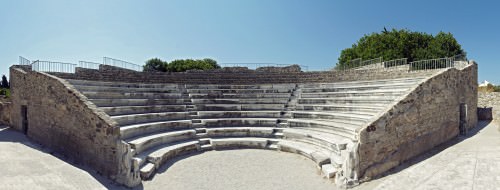
Odeion of Kos
When Rome began to expand its empire from the 2nd century BCE, Kos was made a free city ( civitas libera ). With the fall of the Roman Republic Kos became a part of the province of Asia. Emperor Claudius granted Kos immunitas (immunity from tax or imperial decree) and the island was one again made a free city in the 1st century CE. In late antiquity the island had merely tributary status again.
THE ASCLEPEION
The island today has substantial archaeological remains from all the periods of its history. These include the agora and gymnasium from the Classical periods, and from Hellenistic times, a temple and altar of Dionysos. The Roman period of Kos is represented by baths, a gymnasium, houses, villas – many with their surviving mosaics -, and an early Christian basilica. By far the most significant remains are from the large Asclepeion complex for which the island was most famous in antiquity.
The Asclepeion is situated four kilometres outside the city and dates from the 4th to 2nd century BCE. It was built on an older site sacred to Apollo Cyparissius (referring to the cypress groves in the area), who was, of course, the father of Asclepius, the Greek god of medicine. Initially, the site had only a modest altar but it developed over the years, next with a small Ionic temple built and dedicated to Asclepius, and then, under the auspices of king Eumenes II of Pergamon in the 2nd century BCE, a large Doric temple was built to Asclepius which copied the design of his temple at Epidaurus.
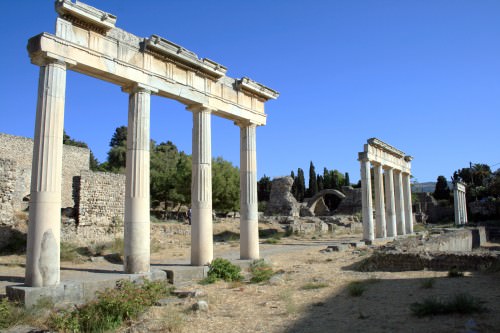
The Hellenistic Gymnasium, Kos
The complex eventually spread over three distinct but connected terraces to better perform its function as a place where visitors from across the Aegean could seek health remedies. Facilities included latrines and baths (1st century CE), temples, a library, fountains, and stoas (open colonnaded buildings) as well as features common to sacred areas such as monumental gates ( propylaea ), exedra (a curved seating area), and rooms for patients and priests. In the 2nd century CE, the Romans built a large temple dedicated to Apollo whose reconstructed columns have been re-stood today. In the 3rd century CE another thermal baths was added to the site, which continued to function into the 5th century CE. In the 6th century CE a Christian church was built in place of the pagan temple, and in medieval times the Knights of St. John reused many blocks of masonry for their castle. The site was rediscovered and excavated from the early 20th century CE, first by a German and then an Italian team of archaeologists.
Asia Minor › Antique Origins
Definition and Origins
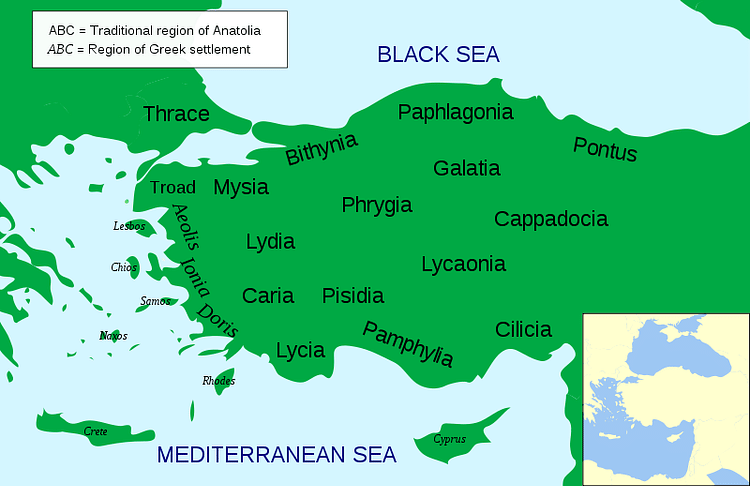
Ancient Asia Minor is a geographic region located in the south-western part of Asia comprising most of what is present-day Turkey. The earliest reference to the region comes from tablets of the Akkadian Dynasty (2334-2083 BCE) where it is known as “The Land of the Hatti ” and was inhabited by the Hittites. The Hittites themselves referred to the land as "Assuwa" (or, earlier, Aswiya) which actually only designated the area around the delta of the river Cayster in Lydia but came to be applied to the entire region. Assuwa is considered the Bronze Age origin for the name `Asia' as the Romans later designated the area.It was called, by the Greeks, “ Anatolia ” (literally, 'place of the rising sun', for those lands to the east of Greece ).
The name 'Asia Minor' (from the Greek `Mikra Asia' - Little Asia) was first coined by the Christian historian Orosius (c. 375-418 CE) in his work Seven Books of History Against the Pagans in 400 CE to differentiate the main of Asia from that region which had been evangelized by the Apostle Paul (which included sites known from Paul's Epistles in the Bible such as Ephesus and Galicia). The Byzantine Empire of the 9th century CE referred to the region as "East Thema" which meant, simply, Eastern Administrative Division, and later sailors called it "The Levant " which meant `the rising' or `to rise' referring to how the land rose up out on the horizon of the sea.
In the ancient world, Asia Minor was the seat of the kingdoms and cities of:
- Thrace
- Bythinia
- Paphlagonia
- Aeloia
- Phrygia
- Galicia
- Pontus
- Armenia
- Urartu
- Assyria
- Cilicia
- Pamphylia
- Lycia
- Pisidia
- Lycanoia
- Caria
- Mysia
- Ionia
- Lydia
- Troy
ASIA MINOR BOASTED SOME OF THE MOST FAMOUS PEOPLE, PLACES & EVENTS IN ANCIENT HISTORY.
The accomplishments and advancements of the people of Asia Minor are vast and comprise a catalogue of some of the most famous people, places, and events in ancient history. According to the historian Philo of Byzantium ( writing in 225 BCE) and later writers, Asia Minor was the site of two of the Seven Wonders of the Ancient World: The Temple of Artemis at Ephesus (in the region of Ionia) and the Tomb of Mauslos at Halicarnassus (also known as The Mausoleum of Halicarnassus, in Caria). In the city of Miletus, in Ionia, the first western philosopher Thales, and his followers Anaximander and Anaximenes, sought the First Cause of existence, the matter which gave birth to all things, and initiated scientific inquiry and method.Herodotus, the `Father of History' was born at Halicarnassus. The great philosopher and mathematician Pythagoras was born on the island of Samos and Heraclitus, another important philosopher, at Ephesus, where he lived and wrote. Cilicia included the city of Tarsus where the Apostle Paul was born, a region known for its expertise in tent making, which was Paul's vocation.
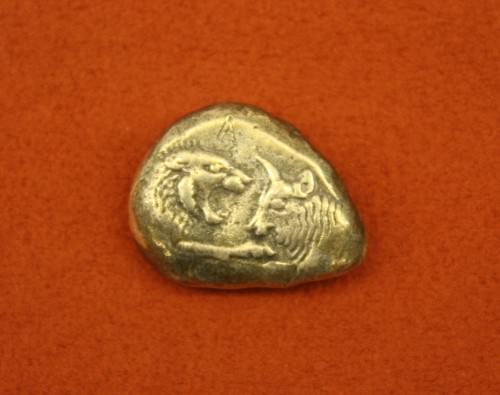
Lydian Silver Stater
Lydia was the kingdom of the great King Croesus who defied the Persian Empire under Cyrus and claimed to be the happiest man in the world until his defeat and capture by the Persians. Lydia was also the site where, in Greek mythology, the Titancalled Asia lived and, earlier, where the great mother goddess Potnia Aswiya (Mistress of Assuwa) was worshipped (who became Artemis and whose great temple was dedicated in the capital of Lydia, at Ephesus). Phrygia was the mythological birthplace of Rhea, the Greek Mother of the Gods and the City of Troy was made famous in Homer ’s 8th century BCE works the Illiad and the Odyssey. The region of Asia Minor is regarded as the birthplace of coinage and the first to use coined money in trade; which of the kingdoms were the first to do this, however, is much disputed.
GREEK COLONISTS SETTLED THE COASTLINE OF ASIA MINOR FROM THE MEDITERRANEAN TO THE BLACK SEA.
Between 1250 and 1200 BCE the Sea People 's invaded from the south, making incursions into Greece, harassing Egypt, and finally driving the Hittites from the region of Assuwa. The Sea Peoples did not remain to colonize the area, however (at least not to any important degree) and eventually moved on to settle, in part, to the south in Canaan. Greek colonists, mainly from Athens and surrounding Attica, settled the coastline of Asia Minor from the Mediterranean up to the Black Sea. It was these Ionian colonies which, supported and funded by Athens and Eretria, rose in revolt when the area came under Persian control, provoking the wrath of the Persian king Darius I and the first invasion of Greece in 490 BCE which was repelled at the Battle of Marathon.
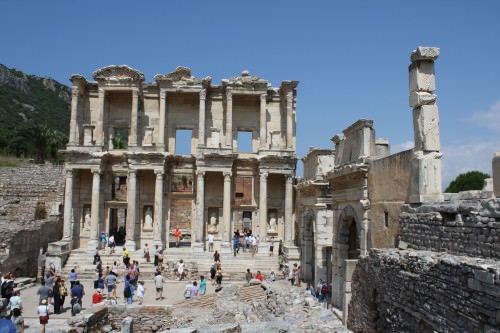
Celsus Library, Ephesos
Alexander the Great defeated the Persians in 334-333 BCE and conquered Asia Minor. In Gordium, capital of Phrygia, he is claimed to have famously cut the Gordian Knot which the oracles claimed meant Alexander would be king of Asia. Following his death the land was governed by his general Antigonus in the north and west and his other general Seleucus to the south and east and was prominently involved in the Wars of the Diadochi (the wars of Alexander's successors). The region remained unstable throughout the rule of the Hellenistic governors until the coming of Rome in 133 BCE (King Attalus III of Pergamon left his city to Rome in his will and thus invited the Roman presence into the region). After 133, Rome steadily conquered or annexed the cities of Asia Minor until it was wholly a Roman province.
Under Roman rule, the land became stabilized; roads were built and the infrastructures of many of the cities improved. The coastal communities flourished and Ephesus, especially, enjoyed great prosperity until the rise of Christianity when `earthly' advances in the region were neglected in anticipation of the Second Coming of Christ. The Byzantine Empire controlled the region after the fall of Rome in 476 CE and, after the rise of Islam, the later Byzantine Christians fought the Islamic Fatimids for the land until the coming of the Seljuq Turks in 1068 CE. Turkish control increased in the region until 1299 CE when Asia Minor became part of the Ottoman Empire and, after its collapse, became Turkey.
LICENSE:
Article based on information obtained from these sources:with permission from the Website Ancient History Encyclopedia
Content is available under License Creative Commons: Attribution-NonCommercial-ShareAlike 3.0 Unported. CC-BY-NC-SA License